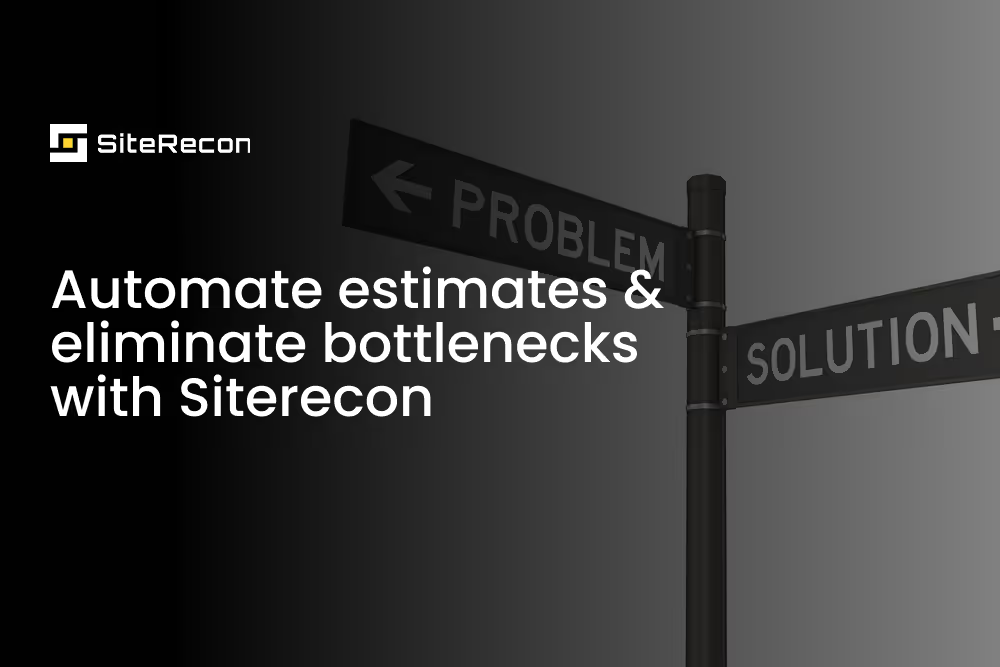Mastering Lawn Care Estimates: 6 Steps to Quote Profitable Jobs
Learn how to estimate lawn care jobs, calculate costs, and set profit margins using tools like SiteRecon Estimator for accurate lawn care pricing.

Key Takeaways:
Running a successful lawn care business boils down to two core elements: keeping your customers satisfied and ensuring your jobs are profitable. A well-thought-out estimation process is critical for both. If you’re just starting out or looking to fine-tune your existing process, accurately quoting lawn care jobs is the key to building a profitable and sustainable business.
In this article, we’ll walk through six crucial steps to help you estimate lawn care jobs effectively. These steps will enable you to offer competitive rates while safeguarding your bottom line.
Why Are Accurate Estimates Important for Lawn Care Businesses?
Accurate estimates are essential for lawn care businesses to stay profitable. Underpricing your services can lead to financial strain, while overpricing can turn potential clients away. The sweet spot is where your price is competitive, but you're also earning enough to grow and sustain your business.
By using modern tools and following a systematic approach, you can avoid guesswork, save time, and create more accurate quotes that benefit both you and your clients. Leveraging platforms like SiteRecon Estimator can further streamline this process by helping you generate estimates based on real-time data and accurate measurements.
Let’s explore the steps that can help you estimate lawn care jobs with precision.
1. Assess the Lawn’s Size and Complexity
Lawn Size: The Primary Factor
The lawn size is the most significant factor in determining the price of a lawn care job. The larger the lawn, the more labor, time, and resources are needed. However, lawn size isn’t the only element to consider—terrain type, obstacles, and ease of access can also affect the job’s complexity.
Measuring Lawn Size
Traditionally, measuring lawn size involved manual methods like measuring wheels or pacing. But with advancements in technology, you can now use satellite imagery or drone technology to measure properties accurately. The SiteRecon Estimator is a great example of a tool that provides precise lawn measurements and property insights in minutes. Using this technology allows you to reduce the time spent on manual measurements while improving accuracy, particularly for large or complex properties.
Not only does this save time, but it also ensures that your quotes are based on solid data, not rough estimates.
Consider Lawn Features
It’s also essential to take note of specific lawn features that can add complexity to a job:
- Slopes or uneven terrain that require extra attention
- Trees, shrubs, and flower beds that need careful trimming
- Hard-to-reach areas that might slow down the job
By accounting for these variables, you can provide a more accurate estimate that reflects the true scope of work required.
READ MORE: How to estimate landscpaing jobs
2. Evaluate the Lawn’s Condition
Lawn Health Impacts Pricing
The current condition of the lawn also plays a significant role in your estimate. A well-maintained lawn may only require basic mowing and edging, while a neglected lawn could need a complete overhaul, including weeding, aeration, and fertilization.
Additional Services for Poor-Condition Lawns
If a lawn is in poor condition, you may need to offer additional services such as:
- Aeration: Loosening compacted soil to promote healthy grass growth.
- Fertilization: Adding nutrients to revitalize the lawn.
- Weed Control: Eliminating invasive plants to improve the lawn’s appearance.
These services can be upsold to clients as part of your estimate, but they also come with additional time and material costs, which need to be reflected in your pricing.
3. Define the Scope of Work
Basic Services to Include
The scope of work will vary depending on the client's needs. For basic lawn care jobs, services typically include:
- Mowing: Regularly cutting the grass to maintain a uniform height.
- Edging: Trimming along sidewalks, driveways, and garden beds.
- Blowing: Clearing grass clippings from hard surfaces.
Expanding the Scope
In addition to basic services, many clients may want or need:
- Fertilization: To promote a healthier lawn.
- Overseeding: To fill in thin or patchy areas.
- Aeration: For loosening compacted soil and promoting better root growth.
The more detailed your scope of work, the more accurate your estimate will be. This also prevents misunderstandings with your client about what’s included in your services.
Using an estimator tool like SiteRecon Estimator helps you clarify the scope of work by giving you a clear picture of the property, allowing you to offer detailed, reliable quotes from the get-go.
4. Calculate Labor Costs
Estimating Labor Time
Labor is usually the largest cost in any lawn care job. Accurately calculating labor time is essential for creating profitable estimates. Factors to consider include:
- How many crew members are needed
- The time it will take to mow, edge, and trim
- Travel time to the job site
A simple formula for estimating labor is: Total labor cost = (Estimated time to complete job) x (Number of workers) x (Hourly wage).
Including Overhead Costs
Remember to account for more than just wages. You’ll also need to cover costs like:
- Payroll taxes
- Workers' compensation
- Insurance
- Equipment maintenance
By calculating labor costs carefully, you can ensure that your estimates will keep your business profitable without overcharging clients.
5. Factor in Material Costs
Materials for Lawn Care Jobs
Most basic lawn care jobs don’t require many materials, but you still need to account for fuel, maintenance, and wear and tear on your equipment. For more extensive jobs that involve fertilization or weed control, you’ll need to factor in the cost of:
- Fertilizers
- Herbicides
- Grass seed (for overseeding)
Seasonal fluctuations can also affect the cost of materials, so make sure you’re adjusting your prices as needed throughout the year.
6. Add Your Profit Margin
Setting the Right Profit Margin
Once you’ve calculated your costs, the final step is to add your profit margin. Typical profit margins in the lawn care industry range between 10% to 30%, depending on factors like job complexity, competition, and your business goals.
Protecting Your Bottom Line
While it might be tempting to lower your margin to win more jobs, your long-term profitability depends on striking the right balance. Make sure your prices reflect the value you offer and account for all of your business expenses.
By integrating tools like SiteRecon Estimator into your quoting process, you can streamline this step and ensure that you are building quotes that not only attract clients but also protect your bottom line.
READ MORE: Landscaping Estimate Template
What’s the Role of Estimation Tools in Lawn Care?
Streamlining Your Estimation Process with Technology
Lawn care estimation tools like SiteRecon Estimator can significantly enhance your ability to deliver accurate and professional quotes. These tools automate many of the manual tasks involved in measuring properties and calculating costs, saving time and reducing human error.
For example, SiteRecon uses satellite imagery to assess property size, layout, and complexity, allowing you to generate an estimate in minutes. This not only improves efficiency but also ensures that your estimates are accurate, leading to better client trust and improved profit margins.
Why Use SiteRecon Estimator?
- Saves Time: No more manual measurements or guesswork.
- Enhances Accuracy: Accurate lawn size measurements lead to more precise quotes.
- Competitive Edge: By offering detailed, data-driven estimates, you can stand out from competitors who rely on rough calculations.
FAQs
Take your business to the next level
Find out how SiteRecon's AI remote takeoff and land measurement tools can speed up pipeline, improve bid accuracy and increase sales

.avif)




